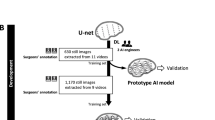Abstract
Deep learning techniques provide a powerful and versatile tool in different areas, such as object segmentation in medical images. In this paper, we propose a network based on the U-Net architecture to perform the segmentation of wounds and staples in abdominal surgery images. Moreover, since both tasks are highly interdependent, we propose a multitask architecture that allows to simultaneously obtain, in the same network evaluation, the masks with the staples and wound location of the image. When performing this multitasking, it is necessary to formulate a global loss function that linearly combines the losses of both partial tasks. This is why the study also involves the GradNorm algorithm to determine which weight is associated to each loss function during each training step. The main conclusion of the study is that multitask segmentation offers superior performance compared to segmenting by separate tasks.
Access this chapter
Tax calculation will be finalised at checkout
Purchases are for personal use only
Similar content being viewed by others
References
Alenezi, F., Armghan, A., Polat, K.: A novel multi-task learning network based on melanoma segmentation and classification with skin lesion images. Diagnostics 13(2), 262 (2023)
Chen, Y.W., Hsu, J.T., Hung, C.C., Wu, J.M., Lai, F., Kuo, S.Y.: Surgical wounds assessment system for self-care. IEEE Trans. Syst. Man Cybern. Syst. 50(12), 5076–5091 (2020)
Chen, Z., Badrinarayanan, V., Lee, C.Y., Rabinovich, A.: Gradnorm: Gradient normalization for adaptive loss balancing in deep multitask networks. In: International Conference on Machine Learning, pp. 794–803. PMLR (2018)
Chino, D.Y., Scabora, L.C., Cazzolato, M.T., Jorge, A.E., Traina, C., Jr., Traina, A.J.: Segmenting skin ulcers and measuring the wound area using deep convolutional networks. Comput. Methods Programs Biomed. 191, 105376 (2020)
González-Hidalgo, M., et al.: Detection and automatic deletion of staples in images of wound of abdominal surgery for m-health applications. In: Tavares, J.M.R.S., Natal Jorge, R.M. (eds.) VipIMAGE 2019. LNCVB, vol. 34, pp. 219–229. Springer, Cham (2019). https://doi.org/10.1007/978-3-030-32040-9_23
González-Hidalgo, M., Munar, M., Bibiloni, P., Moyà-Alcover, G., Craus-Miguel, A., Segura-Sampedro, J.J.: Detection of infected wounds in abdominal surgery images using fuzzy logic and fuzzy sets. In: 2019 International Conference on Wireless and Mobile Computing, Networking and Communications (WiMob), pp. 99–106 (2019)
Kingma, D.P., Ba, J.: Adam: a method for stochastic optimization. In: Bengio, Y., LeCun, Y. (eds.) 3rd International Conference on Learning Representations, ICLR 2015, San Diego, CA, USA, May 7–9, 2015, Conference Track Proceedings (2015)
Liu, C., Fan, X., Guo, Z., Mo, Z., Chang, E.I.C., Xu, Y.: Wound area measurement with 3D transformation and smartphone images. BMC Bioinform. 20(1), 724 (2019)
Mahbod, A., Schaefer, G., Ecker, R., Ellinger, I.: Automatic foot ulcer segmentation using an ensemble of convolutional neural networks. In: 26th International Conference on Pattern Recognition (ICPR), pp. 4358–4364. IEEE Computer Society, Los Alamitos, CA, USA (2022)
Martínez-Ramos, C., Cerdán, M.T., López, R.S.: Mobile phone-based telemedicine system for the home follow-up of patients undergoing ambulatory surgery. Telemed. e-Health 15(6), 531–537 (2009)
Ng, H.J.H., Huang, D., Rajaratnam, V.: Diagnosing surgical site infections using telemedicine: a systematic review. Surgeon 20(4), e78–e85 (2022)
Oliveira, B., et al.: A multi-task convolutional neural network for classification and segmentation of chronic venous disorders. Sci. Rep. 13(1), 761 (2023)
Oota, S.R., Rowtula, V., Mohammed, S., Galitz, J., Liu, M., Gupta, M.: Healtech - a system for predicting patient hospitalization risk and wound progression in old patients. In: IEEE Winter Conference on Applications of Computer Vision (WACV), pp. 2462–2471 (2021)
Ronneberger, O., Fischer, P., Brox, T.: U-Net: convolutional networks for biomedical image segmentation. In: Navab, N., Hornegger, J., Wells, W.M., Frangi, A.F. (eds.) MICCAI 2015. LNCS, vol. 9351, pp. 234–241. Springer, Cham (2015). https://doi.org/10.1007/978-3-319-24574-4_28
Segura-Sampedro, J.J., Rivero-Belenchón, I., et al.: Feasibility and safety of surgical wound remote follow-up by smart phone in appendectomy: a pilot study. Ann. Med. Surg. 21, 58–62 (2017)
Sun, Q., Deng, L., Liu, J., Huang, H., Yuan, J., Tang, X.: Patch-based deep convolutional neural network for corneal ulcer area segmentation. In: Cardoso, M.J., et al. (eds.) FIFI/OMIA -2017. LNCS, vol. 10554, pp. 101–108. Springer, Cham (2017). https://doi.org/10.1007/978-3-319-67561-9_11
Talavera-Martínez, L., Bibiloni, P., González-Hidalgo, M.: A multitasking learning framework for dermoscopic image analysis. In: Tavares, J.M.R.S., Papa, J.P., González Hidalgo, M. (eds.) CIARP 2021. LNCS, vol. 12702, pp. 34–44. Springer, Cham (2021). https://doi.org/10.1007/978-3-030-93420-0_4
Talavera-Martínez, L., Bibiloni, P., Giacaman, A., Taberner, R., Del Pozo Hernando, L.J., González-Hidalgo, M.: A novel approach for skin lesion symmetry classification with a deep learning model. Comput. Biol. Med. 145, 105450 (2022)
Wang, C., Anisuzzaman, D.M., Williamson, V., Dhar, M.K., Rostami, B., Niezgoda, J., Gopalakrishnan, S., Yu, Z.: Fully automatic wound segmentation with deep convolutional neural networks. Sci. Rep. 10(1), 21897 (2020)
Wu, J.M., Tsai, C.J., Ho, T.W., Lai, F., Tai, H.C., Lin, M.T.: A unified framework for automatic detection of wound infection with artificial intelligence. Appl. Sci. 10(15), 5353 (2020)
Acknowledgements
This work was partially supported by the R+D+i Project PID2020-113870GB-I00-“Desarrollo de herramientas de Soft Computing para la Ayuda al Diagnóstico Clínico y a la Gestión de Emergencias (HESOCODICE)”,
funded by MCIN/AEI/10.13039/501100011033/. Project PID2019-104829RA-I00 “EXPLainable Artificial INtelligence systems for health and well-beING (EXPLAINING)” funded by MCIN/AEI/10.13039/501100011033.
Miquel Miró-Nicolau benefited from the fellowship FPI/035/2020 from Govern de les Illes Balears.
Author information
Authors and Affiliations
Corresponding author
Editor information
Editors and Affiliations
Rights and permissions
Copyright information
© 2023 The Author(s), under exclusive license to Springer Nature Switzerland AG
About this paper
Cite this paper
Moyà-Alcover, G., Miró-Nicolau, M., Munar, M., González-Hidalgo, M. (2023). A Multitask Deep Learning Approach for Staples and Wound Segmentation in Abdominal Post-surgical Images. In: Massanet, S., Montes, S., Ruiz-Aguilera, D., González-Hidalgo, M. (eds) Fuzzy Logic and Technology, and Aggregation Operators. EUSFLAT AGOP 2023 2023. Lecture Notes in Computer Science, vol 14069. Springer, Cham. https://doi.org/10.1007/978-3-031-39965-7_18
Download citation
DOI: https://doi.org/10.1007/978-3-031-39965-7_18
Published:
Publisher Name: Springer, Cham
Print ISBN: 978-3-031-39964-0
Online ISBN: 978-3-031-39965-7
eBook Packages: Computer ScienceComputer Science (R0)




